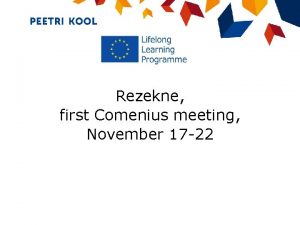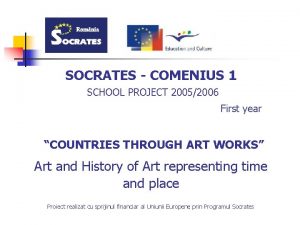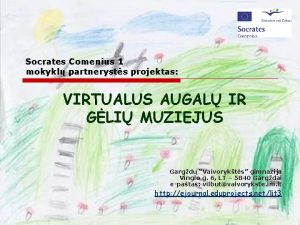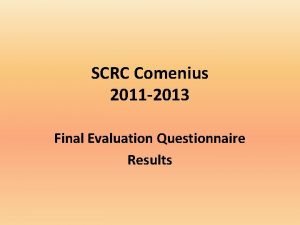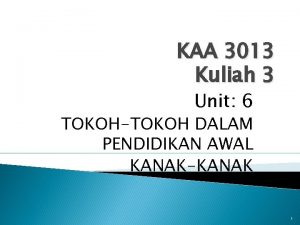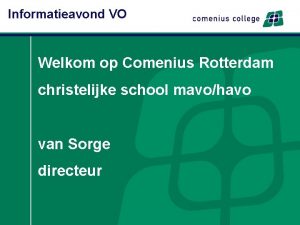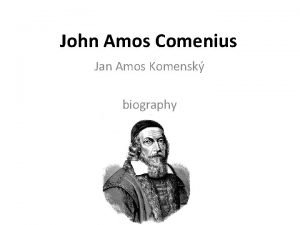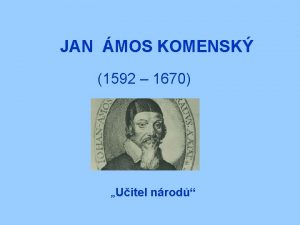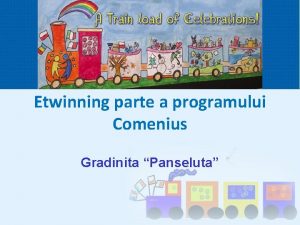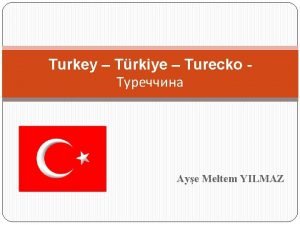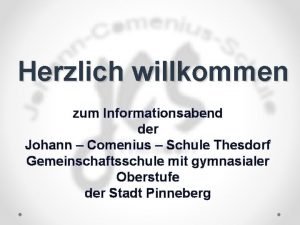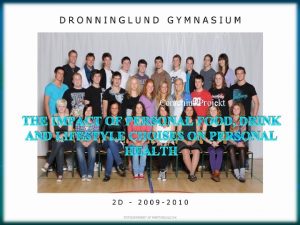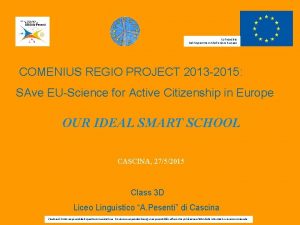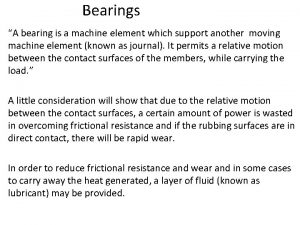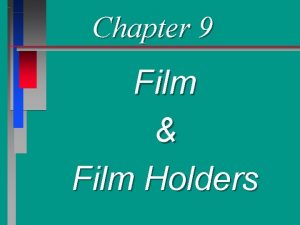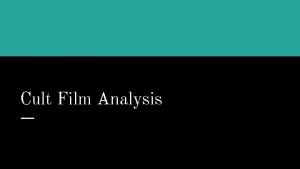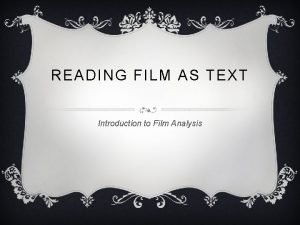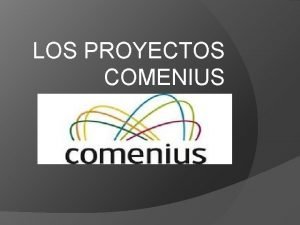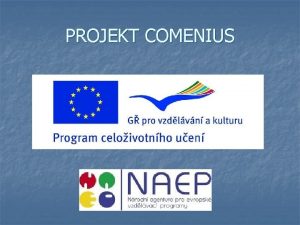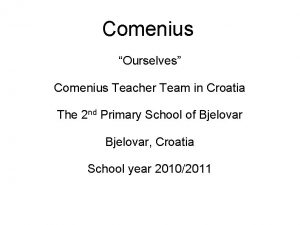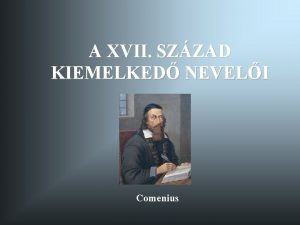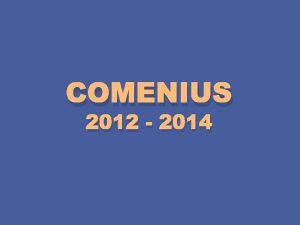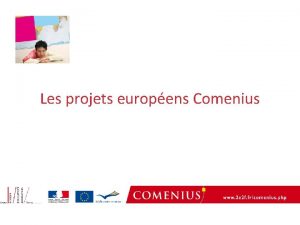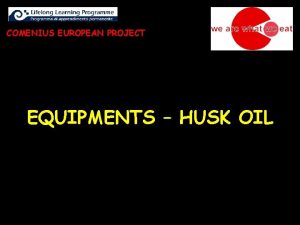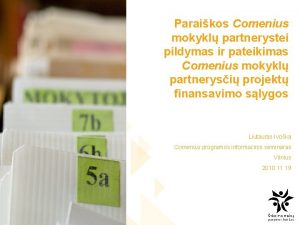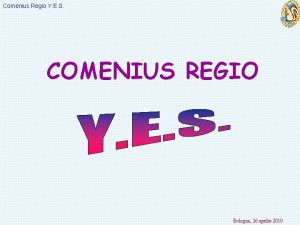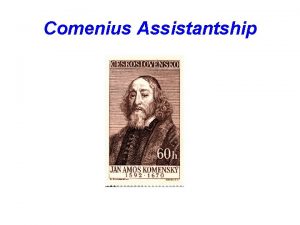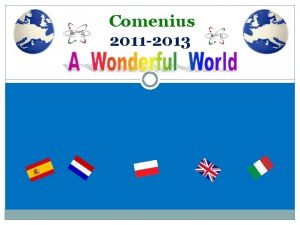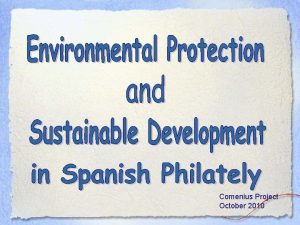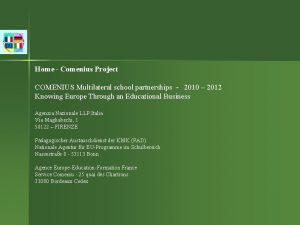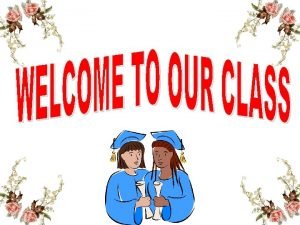Comenius Reading Film Analysis Reading a Film The




































- Slides: 36

Comenius Reading Film Analysis

Reading a Film • The dual nature of film: – Narrative content: • novel • short story – Visual & Aural content: • Painting / photography • Theatre / drama • Symphony / opera

Reading a Film • The Visual & Aural – A unique combination – How films convey the narrative – Less abstract than writing – Must also be "read"

Reading a Film • The Narrative – Films can be compared to written texts. – Contain many narrative elements: • • • Plot / story Characters Setting Point of view Themes / Message

Reading a Film • Film Related to other arts – The novel - expansive scope of narrative – Theatre - visual & aural in real time – Music - evocative like a film's sound picture – Architecture (environmental art) - requires 3 -D spaces

Film Visual • Mise-en-scene – Construction of the scene • How it is done • Meaning of objects • Purpose of the arrangement

Mise-en-scene

Film Visual • Symbolism • Signs / connotations / codes – Cowboy • "merely" a cowboy – ranch hand with specific job • Symbol for: – Masculinity – America – Historical era

Signs / connotations / codes

Signs / connotations / codes

Signs / connotations / codes

Iconography • Objects we EXPECT to see on screen in a certain genre – guns in a thriller – saloon in a western – pretty girls in horror flicks

Iconography

Film Visual • Lighting – create atmosphere and mood – light and shade can suggest codes of meaning (e. g. in a horror film) – strong light is harsh, soft light romantic – spotlight picks someone out – full face = trust and honesty – shadows = fear and lack of trust

Lighting

Low-key lighting • High contrast • Dramatic • Dangerous

High-key lighting • Evenly shaded • Lit background • Non-threatening • Fun

Film Visual • Camera angle – Width • Wide • Normal • Telephoto – Elevation • • High to Bird's-eye view: Eye level Low to Worm's-eye view Canted

Camera angle

Film Visual • Camera and Lens Movement – Left / Right: pan, crab or track – In / Out: zoom or track – Up / Down: tilt or ped – Role – Wild Film (speedy, blurred movement) – Handheld (for closeness, intimacy)

Film Visual • Shot • Editing - the cutting and joining of lengths of film that makes the narrative flow.

Shot • Single take • Size (close-up, long shot, panoramic) • Subjective point-of-view-shot (through the eyes of a character in the movie). • Eye-line shot (that makes YOU feel like you are part of the movie, seeing things from your angle).

Shot Size • Long shot • Medium shot • Close up

Editing • Jump-cut = a dramatic cut that breaks the time continuity/ jumps in time or space • Cross-cut = a cut that follow parallel action in two or more separate scenes at the same time • Follow-cut = follows an action to its consequence • Fade (sometimes into black) • Split screen • Collage/matte

Visual (special) effects • Used to create realism and meaning example: – Space craft in Star Wars – Animated monkey in King Kong

Frame Rate • • • Film speed Time laps fast motion slow motion freeze frame

Film Sound • • • wind-noise screeching cars background music footsteps music for mood etc. narrative (musicals)

Film Sound • Actual sound • Commentary sound

Actual Sound • Voices of characters • Sounds made by objects in the story: coffee cup, foot steps • Music from: instruments, record players, radios, tape players in the scene • Basic sound effects: dog barking, car passing as it is in the scene

Actual Sound

Commentary Sound • • • Narrator's commentary Voice of God Sound effect which is added for dramatic effect Mood music Film Score

Commentary Sound

Genre - type of narrative • • • western detective story musical comedy thriller sci-fi drama action horror

Genre

Analyses • The point of analysis is to figure out: – THEMES: What we should think about – MESSAGES: What we should understand

Further Reading: Monaco, James. How to Read a Film, The Art, Technology, Language, History and Theory of Film and Media. Oxford University Press Inc, USA. 1981. ISBN 0195028066
 Comenius
Comenius Socrates comenius
Socrates comenius Socrates comenius
Socrates comenius Comenius 2011
Comenius 2011 Sumbangan froebel
Sumbangan froebel Comenius rotterdam
Comenius rotterdam John amos comenius background
John amos comenius background Comenius
Comenius Gradinita panseluta
Gradinita panseluta Comenius assistant
Comenius assistant Comenius trento
Comenius trento Jcs thesdorf
Jcs thesdorf Comenius projekt
Comenius projekt Cofinanziato
Cofinanziato Pre reading while reading and post reading activities
Pre reading while reading and post reading activities Wedge film journal bearing
Wedge film journal bearing Hát kết hợp bộ gõ cơ thể
Hát kết hợp bộ gõ cơ thể Ng-html
Ng-html Bổ thể
Bổ thể Tỉ lệ cơ thể trẻ em
Tỉ lệ cơ thể trẻ em Chó sói
Chó sói Chụp phim tư thế worms-breton
Chụp phim tư thế worms-breton Hát lên người ơi alleluia
Hát lên người ơi alleluia Các môn thể thao bắt đầu bằng tiếng đua
Các môn thể thao bắt đầu bằng tiếng đua Thế nào là hệ số cao nhất
Thế nào là hệ số cao nhất Các châu lục và đại dương trên thế giới
Các châu lục và đại dương trên thế giới Công thức tính thế năng
Công thức tính thế năng Trời xanh đây là của chúng ta thể thơ
Trời xanh đây là của chúng ta thể thơ Mật thư tọa độ 5x5
Mật thư tọa độ 5x5 Phép trừ bù
Phép trừ bù Phản ứng thế ankan
Phản ứng thế ankan Các châu lục và đại dương trên thế giới
Các châu lục và đại dương trên thế giới Thể thơ truyền thống
Thể thơ truyền thống Quá trình desamine hóa có thể tạo ra
Quá trình desamine hóa có thể tạo ra Một số thể thơ truyền thống
Một số thể thơ truyền thống Cái miệng bé xinh thế chỉ nói điều hay thôi
Cái miệng bé xinh thế chỉ nói điều hay thôi Vẽ hình chiếu vuông góc của vật thể sau
Vẽ hình chiếu vuông góc của vật thể sau
